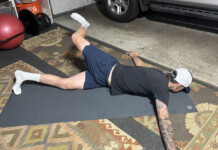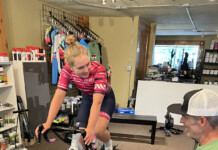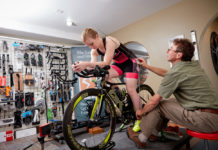Mike Hanseen, manager of Hangar 15 Bicycles in Millcreek, is one of the pillars of the Salt Lake City bicycle community. Mike has been in the bike industry for forty years, having owned Millcreek Bicycles for twenty-five years. He was also a National-level competitive cyclist. I recently have had the pleasure of meeting, working with, and seeing him do what he does best, bicycle fit.
Bicycle fit is a process, and it differs for everyone. Some people think getting a fit and getting sized is the same, but the two are very different.
Sizing takes a few minutes, whereas a proper fit can take a few hours. As someone that has managed three bike shops and worked at about a dozen others around the United States over the past twenty-five years, I can say bike fitting is not the same everywhere. For this article I had the opportunity to sit down with Mike and ask him a few questions about fitting.
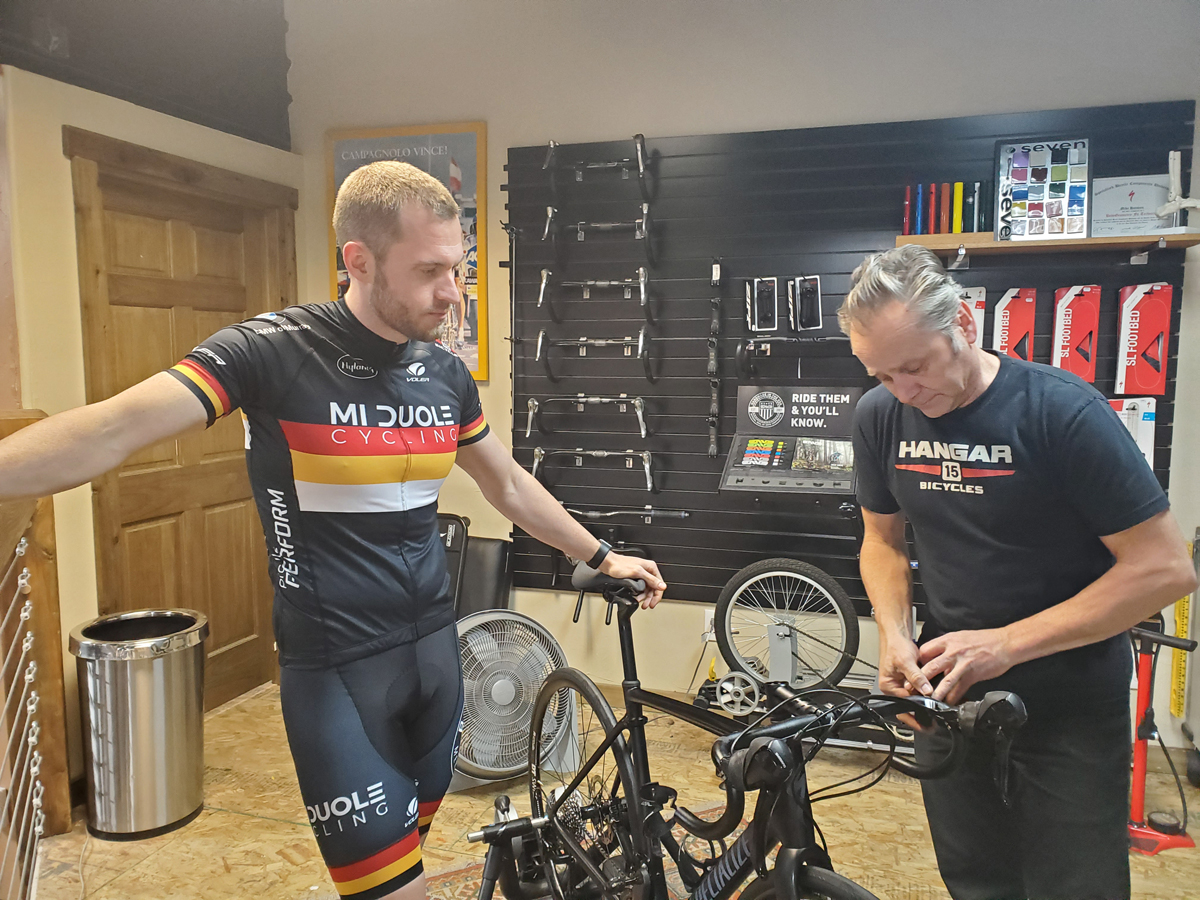
Mike Hanseen working with Graydon Braithwaite’s (Mi Duole Cycling Team) on his bike fit. Photo by Anthony Nocella II
Anthony Nocella: Mike, when did you get into fitting and why?
Mike Hanseen: My first dabble in bicycle fitting was in 1989 after I read Greg Lemond’s Complete Book of Cycling. Lemond’s book had, for the time, a formula to be “properly fit” on a road bike.
My primary goal at the time was to improve my own cycling performance and heal a unilateral strained hamstring. It was moderately successful so I started applying Lemond’s formula to friends’ bicycles as well as to my customers when they would purchase a road bike. I soon discovered Lemond’s formula worked for the youthful racer but not the 50 year old wanting to find fitness on the bike. The very first lesson for me was not to fit everyone as if they were me.
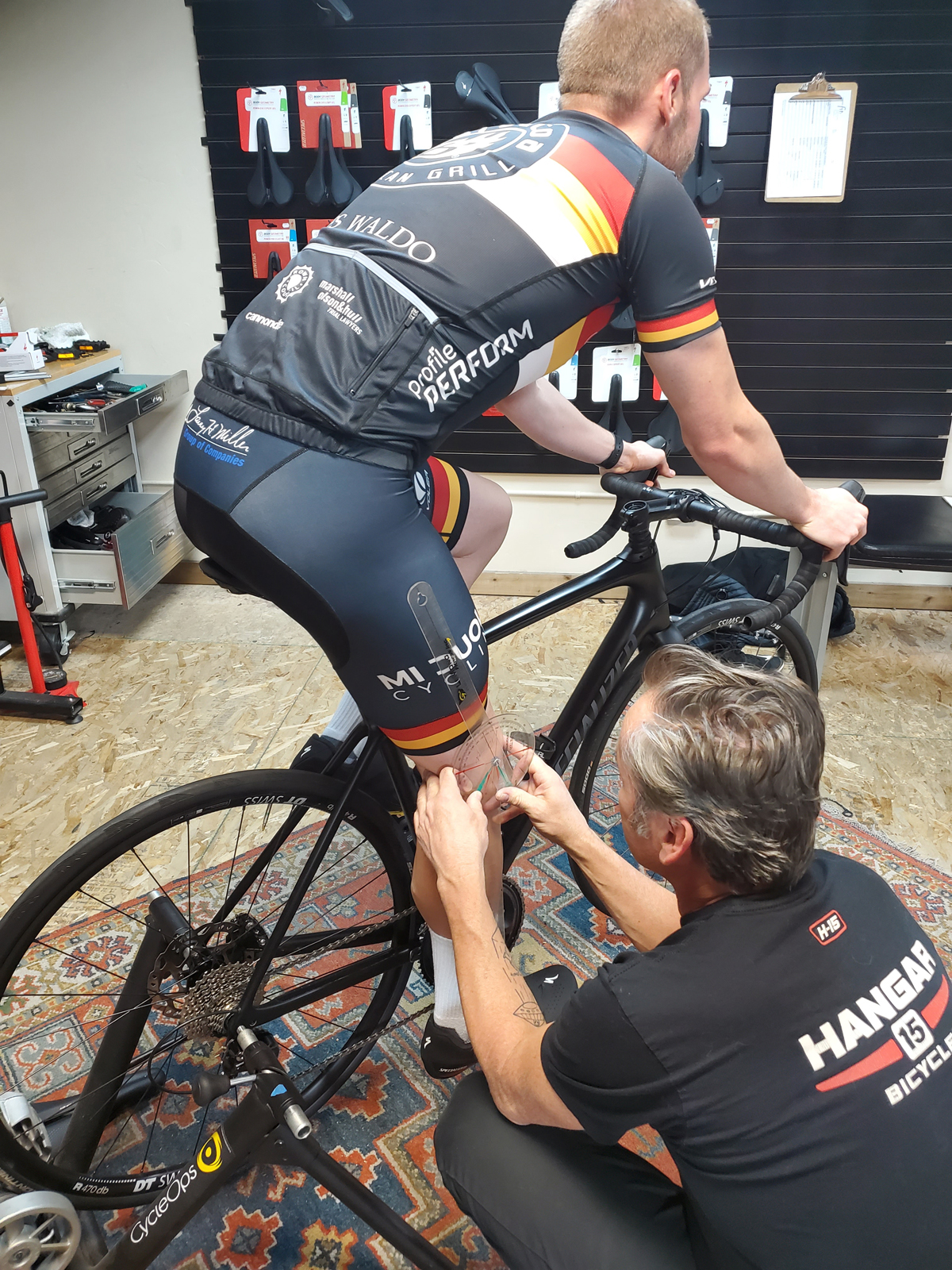
Mike Hanseen adjusts Graydon Braithwaite’s (Mi Duole Cycling Team) bike fit. Photo by Anthony Nocella II
In 1990, I was able to start working with a Serotta Size Cycle. The Serotta Size Cycle was designed to get accurate geometry for Serotta’s custom program as well as, for the era, being a cutting-edge tool for fitting. This fit bike was extremely adjustable and could be set up as any size bike possible. This was a true game changer as it made changes in a fit very quick, giving me and my clients instant feedback, and increased my learning curve as a fitter.
AN: Can you tell me a great story when you were fitting?
MH: About 15 years ago, I had a customer come in with her bike asking me how much her bike was worth. The bike was like new and maybe 2 years old. I asked her why she was selling her bike. She said she loved to ride when she was younger but just can’t ride any longer because it was too painful and she’s too old. She had just turned 52.
I told her it shouldn’t hurt to ride and suggested a fitting. She was skeptical as she was “fit” when she bought the bike. I told her all fits are not the same and at the end of the fitting, if she wasn’t comfortable, then the fit would be free. During the fitting, with every change I made she became more and more optimistic. At the end of the fitting as I’m recording her position she was crying with joy. Literally, with tears she said “I thought I would never ride a bike again”. She is still a customer to this day.
AN: Can you tell me how your fitting has changed over the years and why?
MH: My fitting has completely changed since 1989 for many reasons. When I first opened my shop, I sought out a proprietary method of fitting. One of my main goals was to be able to fit the same person multiple times and get the same result, a goal that no one was achieving at the time.
I dabbled in formulas. Though better than nothing and a decent starting point, formula fittings do not work well. If used they are merely a starting point and should never be used as the final position. It took me about 3 years and 1000 fittings to finally understand what was causing my large margin of error in dynamic fittings.
My knowledge of the human body has come a very long way since I started which has given me the ability to be a better fit tech. Looking at flexibility, muscle recruitment, cycling technique and efficiency, is something I do now that I didn’t understand in 1989.
My understanding of biomechanics and how they integrate with the bicycle have improved immensely. My understanding of bicycle geometry, body position relative to bike handling is another aspect I apply in fittings. One must remember that handling always trumps fit, for a good fit is no good if you’re rubber side up.
AN: Did fitting, which is different than sizing, always exist in the bicycle industry?
MH: A sizing is much different than a fitting but sadly, is often sold as a fitting. Many cyclists are out there thinking they have been fit but were sized. A sizing is very basic but again is better than nothing.
Fittings or fit methods to some degree have existed for a very long time. We’ve all heard to stand over the bike and have 2 inches of clearance, right?
At my first bike shop job in 1980, we fit bikes by having you make a fist then putting your elbow on the nose of the saddle and your fist should just touch the stem bolt. We also would set the saddle height to the point where the customer could barely touch the pedal with their heel., which worked decently unless they had a size 12 foot.
Hamley and Thomas had a formula that dates back to 1967. The Fit Kit was invented in 1982 and Lemond’s method, which was derived from Dr. Ginet’s research, was published in 1989. In my opinion these fit methods have become archaic.
AN: When did bicycle fitting become popular?
MH: Based on my observation, I would say approximately the year 2000. I was averaging 340 bike fits a year from 1995 to 2001. However, I was the only one doing them as a primary fulcrum point of their store.
From 2001, my yearly averages started to fall due to other shops and manufactures applying their efforts in bicycle fitting. I currently perform about 250 fittings a year.
AN: What are the most important issues that must be addressed when fitting someone?
MH: Every detail is important. We are only as strong as our weakest link. If I miss one aspect of a fit and that aspect causes discomfort or pain the cyclist will be drawn too that one negative result.
Every client is different, and their needs are as well. Getting to know a client’s past cycling experience, their current riding volume and future goals is critical. Knowing about past injuries both on and off the bike is also a must.
AN: What are issues that are commonly overlooked when fitting someone?
MH: I think the number one issue overlooked is saddle width. So many fit techs, to this day still do not measure ischial tuberosity width, a very key data point to prevent many injurys; some which can last a lifetime. Another common oversight is the pedal stroke, the linear path of the knee and the causes for the lack thereof.
AN: Can you tell me a horrible example of fitting that you have heard of?
MH: I have seen some insane outcomes at the client’s consequence. In one extreme, I had one client have a saddle set 50 mm too high, causing lumbar degeneration followed by a lumbar fusion. I fit him after his back surgery. This of course is an extreme example. The most common horrible example is when the customer is sold and fit on the wrong size bike.
AN: If someone is going to have a fitting done, what questions and information should be relayed by the customer to the fitter?
MH: Every detail is important even if it seems insignificant. Many clients assume certain types of pain and numbness are normal. I say they are common, but not acceptable. Some clients have a hard time mentioning pain and numbness because of the area of the body the pain and numbness is occurring. Don’t be shy, we need to know and trust me, we have heard it all before.
Mike Hanseen can be reached at the Hangar 15 location in Millcreek, Utah at (801) 278-1500.

